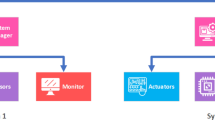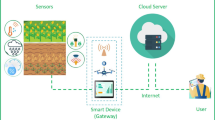Abstract
Cooperative relaying is utilized as an efficient method for data communication in wireless sensor networks and the Internet of Things. However, sometimes due to the necessity of multi-hop relaying in such communication networks, it is challenging to guarantee the secrecy of cooperative transmissions when the relays may themselves be eavesdroppers, i.e., we may face with the untrusted relaying scenario where the relays are both necessary helpers and potential adversary. To obviate this issue, a new cooperative jamming scheme is proposed in this paper, in which the data can be confidentially communicated from the source to the destination through multiple untrusted relays. In our proposed secure transmission scheme, all the legitimate nodes contribute to providing secure communication by intelligently injecting artificial noises to the network in different communication phases. For the sake of analysis, we consider a multi-hop untrusted relaying network with two successive intermediate nodes, i.e, a three-hop communications network. Given this system model, a new closed-form expression is presented in the high signal-to-noise ratio (SNR) regime for the Ergodic secrecy rate (ESR). Furthermore, we evaluate the high-SNR slope and power offset of the ESR to gain an insightful comparison of the proposed secure transmission scheme and the state-of-arts. Our numerical results highlight that the proposed secure transmission scheme provides better secrecy rate performance compared with the two-hop untrusted relaying as well as the direct transmission schemes.






Similar content being viewed by others
Notes
Note that this is a valid assumption for terrestrial networks, however, our work can be readily extended to consider other channel modeling based on the applications of interest, such as UAV-ground based channels as considered in [13].
References
Zou, Y., Zhu, J., Wang, X., & Hanzo, L. (2016). A survey on wireless security: Technical challenges, recent advances, and future trends. Proceedings of the IEEE, 104(9), 1727–1765.
Memon, I., Ali, Q., Zubedi, A., & Mangi, F. A. (2017). DPMM: dynamic pseudonym-based multiple mix-zones generation for mobile traveler. Multimedia Tools and Applications, 76(22), 24359–24388.
Mukherjee, A., Fakoorian, S. A. A., Huang, J., & Swindlehurst, A. L. (2014). Principles of physical-layer security in multiuser wireless networks: A survey. IEEE Communication on Surveys and Tutorials, 16(3), 3062–3080.
Wang, N., Wang, P., Alipour-Fanid, A., Jiao, L., & Zeng, K. (2019). Physical-layer security of 5G wireless networks for IoT: Challenges and opportunities. IEEE Internet of Things Journal, 6(5), 8169–8181.
Yener, A., & Ulukus, S. (2015). Wireless physical-layer security: Lessons learned from information theory. Proceedings of the IEEE, 103(10), 1814–1825.
Yang, N., Wang, L., Geraci, G., Elkashlan, M., Yuan, J., & Renzo, M. D. (2015). Safeguarding 5G wireless communication networks using physical layer security. IEEE Communications Magazine, 53(4), 20–27.
Wang, N., Wang, P., Alipour-Fanid, A., Jiao, L., & Zeng, K. (2019). Physical layer security of 5G wireless networks for IoT: Challenges and opportunities. IEEE Internet of Things Journal, 6(5), 8169–8181.
Hamamreh, J. M., Furqan, H. M., & Arslan, H. (2018). Classifications and applications of physical layer security techniques for confidentiality: A comprehensive survey. IEEE Communications Surveys and Tutorials, 21(2), 1773–1828.
Sun, L., & Du, Q. (2018). A review of physical layer security techniques for internet of things: Challenges and solutions. Entropy, 20(10), 730.
Yang, N., Yan, S., Yuan, J., Malaney, R., Subramanian, R., & Land, I. (2015). Artificial noise: Transmission optimization in multi-input single-output wiretap channels. IEEE Transactions on Communications, 63(5), 1771–1783.
Wang, L., Cai, Y., Zou, Y., Yang, W., & Hanzo, L. (2015). Joint relay and jammer selection improves the physical layer security in the face of CSI feedback delays. IEEE Transactions on Vehicular Technology, 65(8), 6259–6274.
Tatar Mamaghani, M., & Hong, Y. (2020). Improving PHY-security of UAV-enabled transmission with wireless energy harvesting: Robust trajectory design and communications resource allocation. IEEE Transactions on Vehicular Technology, 69(8), 8586–8600.
Tatar Mamaghani, M., & Hong, Y. (2019). On the performance of low-altitude UAV-enabled secure AF relaying with cooperative jamming and SWIPT. IEEE Access, 7, 153060–153073.
Kuhestani, A., Mohammadi, A., & Yeoh, P. L. (2018). Security-reliability trade-off in cyber-physical cooperative systems with non-ideal untrusted relaying. In 2018 IEEE 4th World Forum on Internet of Things (WF-IoT), Singapore, (pp. 552–557).
Tatar Mamaghani, M., Mohammadi, A., Yeoh, P. L., & Kuhestani, A. (2017). Secure two-way communication via a wireless powered untrusted relay and friendly jammer. Paper presented at the GLOBECOM 2017 IEEE Global Communications Conference.
Shakhatreh, H., et al. (2019). Unmanned aerial vehicles (UAVs): A survey on civil applications and key research challenges. IEEE Access, 7, 48572–48634.
Chen, Y., Zhao, N., Ding, Z., & Alouini, M. (2018). Multiple UAVs as relays: Multi-hop single link versus multiple dual-hop links. IEEE Transactions on Wireless Communications, 17(9), 6348–6359.
Abro, A., et al., (2019). Minimizing Energy Expenditures using Genetic Algorithm for Scalability and Longlivety of Multi hop Sensor Networks. In 2019 IEEE 9th International Conference on Electronics Information and Emergency Communication (ICEIEC) (pp. 183–187).
Hasan, M. K., Ismail, A. F., Islam, S., Hashim, W., Ahmed, M. M., & Memon, I. (2019). A novel HGBBDSA-CTI approach for subcarrier allocation in heterogeneous network. Telecommunication Systems, 70(2), 245–262.
Abdo, A. M. A., Zhao, X., Zhang, R., Zhou, Z., Zhang, J., Zhang, Y., et al. (2018). MU-MIMO downlink capacity analysis and optimum code weight vector design for 5G big data massive antenna millimeter wave communication. Wireless Communications and Mobile Computing,. https://doi.org/10.1155/2018/7138232.
Sung, Y., Lee, S., & Lee, M. (2018). A multi-hop clustering mechanism for scalable IoT networks. Sensors,. https://doi.org/10.3390/s18040961.
He, X., & Yener, A. (2008). Two-hop secure communication using an untrusted relay: A case for cooperative jamming. In Proceedings of IEEE Globecom, (pp. 1–5). New Orleans, LA .
Sun, L., Ren, P., Du, Q., Wang, Y., & Gao, Z. (2014). Security-aware relaying scheme for cooperative networks with untrusted relay nodes. IEEE Communications Letters, 19(3), 463–466.
Tatar Mamaghani, M., Kuhestani, A., & Wong, K.-K. (2018). Secure two-way transmission via wireless-powered untrusted relay and external jammer. IEEE Transactions on Vehicular Technology, 67(9), 8451–8465.
Tatar Mamaghani, M., & Abbas, R. (2019). Security and reliability performance analysis for two-way wireless energy harvesting based untrusted relaying with cooperative jamming. IET Communications, 13(4), 449–459.
Kuhestani, A., Mohammadi, A., & Mohammadi, M. (2018). Joint relay selection and power allocation in large-scale MIMO systems with untrusted relays and passive eavesdroppers. IEEE Transactions on Information Forensics and Security, 13(2), 341–355.
Zhang, G., Yan, H., Zeng, Y., Cui, M., & Liu, Y. (2018). Trajectory optimization and power allocation for multi-hop UAV relaying communications. IEEE Access, 6, 48566–48576.
Wang, H., Zhang, Y., Ng, D. W. K., & Lee, M. H. (2018). Secure routing with power optimization for ad-hoc networks. IEEE Transactions on Communications, 66(10), 4666–4679.
Yao, J., Zhou, X., Liu, Y., & Feng, S. (2018). Secure transmission in linear multi-hop relaying networks. IEEE Transactions on Wireless Communications, 17(2), 822–834.
He, X., & Yener, A. (2013). End-to-end secure multi-hop communication with untrusted relays. IEEE Transactions on Wireless Communications, 12(1), 1–11.
Mirmohseni, M., & Papadimitratos, P. (2014). Colluding eavesdroppers in large cooperative wireless networks. In 2014 IEEE Iran Workshop on Communication and Information Theory (IWCIT), (pp. 1-6).
Zhao, X., Abdo, A. M. A., Xu, C., Geng, S., Zhang, J., & Memon, I. (2017). Dimension reduction of channel correlation matrix using CUR-decomposition technique for 3D massive antenna system. IEEE Access, 6, 3031–3039.
Gradshteyn, I. S., & Ryzhik, I. M. (2007). Table of integrals, series, and products (7th ed.). New York: Academic.
Molu, M. M., Xiao, P., Khalily, M., Zhang, L., & Tafazolli, R. (2017). A novel equivalent definition of modified Bessel functions for performance analysis of multi-hop wireless communication systems. IEEE Access, 5, 7594–7605.
Bjornson, E., Matthaiou, M., & Debbah, M. (2013). A new look at dual-hop relaying: Performance limits with hardware impairments. IEEE Transactions on Communications, 61(11), 4512–4525.
Author information
Authors and Affiliations
Corresponding author
Additional information
Publisher's Note
Springer Nature remains neutral with regard to jurisdictional claims in published maps and institutional affiliations.
Appendices
A Proof of Lemma 2
The CDF of \(Z=\frac{X}{Y}\) has been derived in [14]. To obtain the CDF of \(W=\frac{XY}{X+Y}\), we start from the definition of CDF as
Finally, after calculating the integral term using [33, Eq. (3.324.1)], one can obtain the expression given in (11). \(\square \)
B Proof of Lemma 3
In the following, we proceed to prove Lemma 3 wherein the different exact/approximate expressions for \({\mathcal {P}}\), \({\mathcal {T}}_1\), and \({\mathcal {T}}_2\) are given.
A. Calculating \({\mathcal {P}}\) Plugging (5) into \({\mathcal {P}}=\Pr \{\gamma ^{(1)}_{R_1}>\gamma ^{(2)}_{R_2}\}\), and then defining \(X=\gamma _f\), \(Y=\gamma _h\) and \(Z=\gamma _g\), we get
where (a) follows from defining the auxiliary variables \(u=y+z\) and \(v=y\), (b) follows from using [33, Eq. (3.324.1)] and [33, Eq. (3.351.3)], (c) follows from substituting the equivalent series of modified Bessel function of the second kind and first order as presented in [34], which is a well-tight approximation with finite series, as observed later in numerical results. For \(\nu >0\) and positive integer M which controls the accuracy of infinite series, we have [34]
Finally, (d) presents the first term of the infinite series given for \(M=1\) to have a closed-form approximation. We will show in the simulation results how this simple closed-form expression works well.
B. Calculating \(T_1\) Using Lemma 2, we can derive a closed-form expression for \(T_{1}\), after assuming \(X=\frac{\gamma _g}{\gamma _h}\), as
where (a) follows from integration by parts law. Then, computing the last integral, considering \(F_X(x)\) given in Lemma 2, leads to the closed-form expression for \(T_1\) given in (27).
C. Calculating \(T_2\) The part \(T_{2}\) can be mathematically calculated as
where (a) follows after using the approximation \({\mathbb{E}}\left\{ \log \left( 1+\frac{X}{Y}\right) \right\} \approx \log \left( 1+\frac{{\mathbb{E}}\{X\}}{{\mathbb{E}}\{Y\}}\right) \) given in [35]. Thus, after further calculation, using Lemma 2, one can obtain \(T_2\) in (27). \(\square \)
Rights and permissions
About this article
Cite this article
Mamaghani, M.T., Kuhestani, A. & Behroozi, H. Can a multi-hop link relying on untrusted amplify-and-forward relays render security?. Wireless Netw 27, 795–807 (2021). https://doi.org/10.1007/s11276-020-02487-w
Accepted:
Published:
Issue Date:
DOI: https://doi.org/10.1007/s11276-020-02487-w




